Online stress and offline stress: Uniqueness, differences, and cumulative effect on multiple well-being outcomes
Vol.18,No.2(2024)
There is an increasing interaction between our offline and online lives, which puts forward a challenge to understanding the relationship between stress and health, as online and offline stress may be mixed. This study used 4,127 adolescents to test the uniqueness of online stress, the distinction between online and offline stress, and their co-occurrence and cumulative effects. The results showed that after controlling for offline stress, online stress still contributed to multiple well-being outcomes. Correspondence analysis revealed that online stress was more similar to daily hassles/perceived stress (global stress) compared to major life events. Latent profile analysis (LPA) revealed that adolescents who experienced certain levels of offline stress also experienced similar levels of online stress, indicating that they co-occur. Besides, the predictions of online and the three types of offline stress are consistent with the cumulative damage hypothesis of stress. Its theoretical and practical implications are discussed.
online stress; offline stress; smartphone stress; perceived stress; multiple well-being outcomes
Shunsen Huang
State Key Laboratory of Cognitive Neuroscience and Learning, Beijing Normal University, Beijing, China
Shunsen Huang is a doctoral candidate in the State Key Laboratory of Cognitive Neuroscience and learning, at Beijing Normal University. His research interests focus to explore how addictive media use (e.g., problematic smartphone use), avoidant media use (e.g., smartphone stress, discontinuous media use), digital coping and artificial intelligence use influence adolescents’ development in emotion, mental health, and external behavior.
Xiaoxiong Lai
State Key Laboratory of Cognitive Neuroscience and Learning, Beijing Normal University, Beijing, China; Institute of Digital Education, China National Academy of Educational Sciences, Beijing, China
Xiaoxiong Lai is an assistant professor in the Institute of Digital Education at the China National Academy of Educational Sciences, Beijing, China. He is interested in the relationship between media use and interpersonal relationships as well as potential mechanisms, and the development of addictive media use behavior among children and adolescents. He is also interested in adolescents’ mental health, growth mindset, digital literacy, and artificial intelligence use etc.
Lara Wolfers
Amsterdam School of Communication Research (ASCoR), University of Amsterdam, Amsterdam, Netherlands
Lara N. Wolfers is an assistant professor in the Youth and Media Programme Group at the Amsterdam School of Communication Research (ASCoR), University of Amsterdam. She has completed her PhD in communication science at the Leibniz-Institut für Wissensmedien, Tübingen. Her work focuses on social and mobile media use in the family and on how media are used for coping with stress.
Yajun Li
Shenzhen Institute of Education Sciences, Shenzhen, China
Yajun Li is a researcher at Shenzhen Institute of Education Sciences, Shenzhen, China. He is interested in educational quality monitoring and assessment as well as school mental health education.
Xinran Dai
State Key Laboratory of Cognitive Neuroscience and Learning, Beijing Normal University, Beijing, China
Xinran Dai is a Master’s degree candidate in the State Key Laboratory of Cognitive Neuroscience and Learning, Beijing Normal University. Her research interests are related to materialism, online interpersonal relationships, and digital media use.
Xinmei Zhao
State Key Laboratory of Cognitive Neuroscience and Learning, Beijing Normal University, Beijing, China
Xinmei Zhao is a master’s candidate in the State Key Laboratory of Cognitive Neuroscience and Learning, at Beijing Normal University. She is interested in the relationships between smartphone use, physical activity and mental health among adolescents and the underlying mechanisms of these relationships.
Hongyun Wu
Qujing NO.2 Middle School, Qujing, Yunnan, China
Hongyun Wu is a teacher at QuJing No.2 Middle School, Qujing, China. She is interested in the mental health education among adolescents.
Sirong Song
Chengdu Shifan Primary School, Chengdu, Sichuang, China
Sirong Song is a teacher at Chengdu Shifan Primary School, Chengdu, China. She is interested in adolescent social-emotional learning and aims at improving the social-emotional ability of youth.
Huanlei Wang
State Key Laboratory of Cognitive Neuroscience and Learning, Beijing Normal University, Beijing, China
Huanlei Wang is a master’s candidate in the State Key Laboratory of Cognitive Neuroscience and Learning, Beijing Normal University. Her research interests focused on the interaction between adolescents and artificial intelligence products, especially the interaction with dialogue artificial intelligence. She mainly studies the impact and mechanism of the interaction on their mental health and interpersonal relationships.
Ying He
State Key Laboratory of Cognitive Neuroscience and Learning, Beijing Normal University, Beijing, China
Ying He is currently studying for his master’s degree at the State Key Laboratory of Cognitive Neuroscience and Learning, Beijing Normal University. His research interests lie in the impact of people’s technology use on mental health and well-being.
Yun Wang
State Key Laboratory of Cognitive Neuroscience and Learning, Beijing Normal University, Beijing, China
Yun Wang is a Professor in the State Key Laboratory of Cognitive Neuroscience and Learning, Beijing Normal University. Her interests are related to children’s and adolescents’ mental health and environment, including 1) internal and external behaviors, problematic smartphone use, 2) environmental factors related to the development of children and adolescents, and 3) School assessment centered on student learning and development.
Abdi, H., & Béra, M. (2017). Correspondence analysis. In R. Alhajj & J. Rokne (Eds.), Encyclopedia of social network analysis and mining (pp. 1–12). Springer. https://doi.org/10.1007/978-1-4614-7163-9_140-2
Andreas, J. B., & Brunborg, G. S. (2017). Depressive symptomatology among Norwegian adolescent boys and girls: The Patient Health Questionnaire-9 (PHQ-9) psychometric properties and correlates. Frontiers in Psychology, 8(887), 1–11. https://doi.org/10.3389/fpsyg.2017.00887
Au, T. M., Dickstein, B. D., Comer, J. S., Salters-Pedneault, K., & Litz, B. T. (2013). Co-occurring posttraumatic stress and depression symptoms after sexual assault: A latent profile analysis. Journal of Affective Disorders, 149(1–3), 209–216. https://doi.org/10.1016/j.jad.2013.01.026
Brivio, E., Gaudioso, F., Vergine, I., Mirizzi, C. R., Reina, C., Stellari, A., & Galimberti, C. (2018). Preventing technostress through positive technology. Frontiers in Psychology, 9, 2569. https://doi.org/10.3389/fpsyg.2018.02569
CNNIC. (2020). China research report on Internet use of juveniles 2019. http://www.cnnic.net.cn/n4/2022/0401/c116-1117.html
CNNIC. (2021). China research report on Internet use of juveniles 2020. https://www.cnnic.net.cn/6/86/116/index.html
Cohen, S. (1988). Perceived stress in a probability sample of the United States. In S. Spacapan & S. Oskamp (Eds.), The social psychology of health (pp. 31–67). Sage Publications.
Cohen, S., Kamarck, T., & Mermelstein, R. (1983). A global measure of perceived stress. Journal of Health and Social Behavior, 24(4), 385–396. https://doi.org/10.2307/2136404
Crone, E. A., & Konijn, E. A. (2018). Media use and brain development during adolescence. Nature Communications, 9(1), 1–10. https://doi.org/10.1038/s41467-018-03126-x
De Benedittis, G., & Lorenzetti, A. (1992). The role of stressful life events in the persistence of primary headache: Major events vs. daily hassles. Pain, 51(1), 35–42. https://doi.org/10.1016/0304-3959(92)90006-W
DeLongis, A., Coyne, J. C., Dakof, G., Folkman, S., & Lazarus, R. S. (1982). Relationship of daily hassles, uplifts, and major life events to health status. Health Psychology, 1(2), 119–136. https://doi.org/10.1037/0278-6133.1.2.119
Diener, E., Emmons, R. A., Larsen, R. J., & Griffin, S. (1985). The Satisfaction With Life Scale. Journal of Personality Assessment, 49(1), 71–75. https://doi.org/10.1177/0748175611422898
Dragano, N., & Lunau, T. (2020). Technostress at work and mental health: Concepts and research results. Current Opinion in Psychiatry, 33(4), 407–413. https://doi.org/10.1097/YCO.0000000000000613
Evans, G. W., & Whipple, S. S. (2013). Cumulative risk and child development. Psychological Bulletin, 139(6), 1342–1396. https://doi.org/10.1037/a0031808
Freytag, A., Knop-Huelss, K., Meier, A., Reinecke, L., Hefner, D., Klimmt, C., & Vorderer, P. (2021). Permanently online-always stressed out? The effects of permanent connectedness on stress experiences. Human Communication Research, 47(2), 132–165. https://doi.org/10.1093/hcr/hqaa014
Greenacre, M. (2007). Correspondence Analysis in Practice (2nd ed.). Chapman and Hall/CRC. https://doi.org/10.1201/9781420011234
Hahn, S. E., & Smith, C. S. (1999). Daily hassles and chronic stressors: Conceptual and measurement issues. Stress Medicine, 15(2), 89–101. https://doi.org/10.1002/(SICI)1099-1700(199904)15:2<89::AID-SMI789>3.0.CO;2-O
Hall, J. A., Miller, A. J., & Christofferson, J. L. (2021, November). Digital stress as a mediator of the association between mobile and social media use and psychological functioning. [Paper presentation]. National Communication Association Conference in Seattle, WA, USA. https://hdl.handle.net/1808/33337
Hall, J. A., Steele, R. G., Christofferson, J. L., Mihailova, T., & Steele, R. G. (2021). Development and initial evaluation of a Multidimensional Digital Stress Scale. Psychological Assessment, 33(3), 230–242. https://doi.org/10.1037/pas0000979
Hart, S. A., Logan, J. A. R., Thompson, L., Kovas, Y., McLoughlin, G., & Petrill, S. A. (2016). A latent profile analysis of math achievement, numerosity, and math anxiety in twins. Journal of Educational Psychology, 108(2), 181–193. https://doi.org/10.1037/edu0000045
Hefner, D., & Vorderer, P. (2017). Digital stress: Permanent connectedness and multitasking. In L. Reinecke & M.-B. Oliver (Eds.), The Routledge handbook of media use and well-being: International perspectives on theory and research on positive media effects (pp. 237–249). Routledge.
Huang, S., Lai, X., Ke, L., Qin, X., Yan, J. J., Xie, Y., Dai, X., & Wang, Y. (2022). Smartphone stress: Concept, structure, and development of measurement among adolescents. Cyberpsychology: Journal of Psychosocial Research on Cyberspace, 16(5), Article 1. https://doi.org/10.5817/CP2022-5-1
Hudiburg, R. A. (1991). Relationship of computer hassles, somatic complaints, and daily hassles. Psychological Reports, 69, 1119–1122. https://doi.org/10.2466/pr0.1991.69.3f.1119
Hudiburg, R. A. (1992). Factor analysis of the computer technology hassles scale. Psychological Reports, 71, 739–744. https://doi.org/10.2466/pr0.1992.71.3.739
Jassi, A., Lenhard, F., Krebs, G., Gumpert, M., Jolstedt, M., Andrén, P., Nord, M., Aspvall, K., Wahlund, T., Volz, C., & Mataix-Cols, D. (2020). The Work and Social Adjustment Scale, Youth and Parent versions: Psychometric evaluation of a brief measure of functional impairment in young people. Child Psychiatry and Human Development, 51(3), 453–460. https://doi.org/10.1007/s10578-020-00956-z
Johnson, G. M. (2010). Internet use and child development: The techno-microsystem. Australian Journal of Educational and Developmental Psychology, 10(780), 32–43. https://eric.ed.gov/?id=EJ885705
Johnson, G. M., & Puplampu, P. (2008). A conceptual framework for understanding the effect of the Internet on child development: The ecological techno-subsystem. Canadian Journal of Learning and Technology, 34, 19–28. http://hdl.handle.net/20.500.11937/13183
Johnston, C. A., Steele, R. G., Herrera, E. A., & Phipps, S. (2003). Parent and child reporting of negative life events: Discrepancy and agreement across pediatric samples. Journal of Pediatric Psychology, 28(8), 579–588. https://doi.org/10.1093/jpepsy/jsg048
Jung, T., & Wickrama, K. A. S. (2008). An Introduction to latent class growth analysis and growth mixture modeling. Social and Personality Psychology Compass, 2(1), 302–317. https://doi.org/10.1111/j.1751-9004.2007.00054.x
Kanner, A. D., Coyne, J. C., Schaefer, C., & Lazarus, R. S. (1981). Comparison of two modes of stress measurement: Daily hassles and uplifts versus major life events. Journal of Behavioral Medicine, 4(1), 1–39. https://doi.org/10.1007/BF00844845
Khangar, N. V., & Kamalja, K. K. (2017). Multiple Correspondence Analysis and its applications. Electronic Journal of Applied Statistical Analysis, 10(2), 432–462. https://www.researchgate.net/publication/320694285_Multiple_Correspondence_Analysis_and_its_applications
Kushner, S. C., & Tackett, J. L. (2017). Parent and adolescent agreement for reports of life stressors. Assessment, 24(2), 143–156. https://doi.org/10.1177/1073191115607972
Lupien, S. J., Juster, R. P., Raymond, C., & Marin, M. F. (2018). The effects of chronic stress on the human brain: From neurotoxicity, to vulnerability, to opportunity. Frontiers in Neuroendocrinology, 49, 91–105. https://doi.org/10.1016/j.yfrne.2018.02.001
Mackenzie, M. J., Kotch, J. B., & Lee, L. (2011). Toward a cumulative ecological risk model for the etiology of child maltreatment. Children and Youth Services Review, 33(9), 1638–1647. https://doi.org/10.1016/j.childyouth.2011.04.018
Martin, R. A., Kazarian, S. S., & Breiter, H. J. (1995). Perceived stress, life events, dysfunctional attitudes, and depression in adolescent psychiatric inpatients. Journal of Psychopathology and Behavioral Assessment, 17(1), 81–95. https://doi.org/10.1007/BF02229205
McFarland, L. A., & Ployhart, R. E. (2015). Social media: A contextual framework to guide research and practice. Journal of Applied Psychology, 100(6), 1653–1677. https://doi.org/10.1037/a0039244
Mechanic, D., & Hansell, S. (1987). Adolescent competence, psychological well-being, and self-assessed physical health. Journal of Health and Social Behavior, 28(4), 364–374. https://doi.org/10.2307/2136790
Navarro, J. L., & Tudge, J. R. H. (2023). Technologizing Bronfenbrenner: Neo-ecological theory. Current Psychology, 42(22), 19338–19354. https://doi.org/10.1007/s12144-022-02738-3
Nesi, J., Choukas-Bradley, S., & Prinstein, M. J. (2018a). Transformation of adolescent peer relations in the social media context: Part 1—A theoretical framework and application to dyadic peer relationships. Clinical Child and Family Psychology Review, 21(3), 267–294. https://doi.org/10.1007/s10567-018-0261-x
Nesi, J., Choukas-Bradley, S., & Prinstein, M. J. (2018b). Transformation of adolescent peer relations in the social media context: Part 2—Application to peer group processes and future directions for research. Clinical Child and Family Psychology Review, 21(3), 295–319. https://doi.org/10.1007/s10567-018-0262-9
Nick, E. A., Kilic, Z., Nesi, J., Telzer, E. H., Lindquist, K. A., & Prinstein, M. J. (2022). Adolescent digital stress: Frequencies, correlates, and longitudinal association with depressive symptoms. Journal of Adolescent Health, 70(2), 336–339. https://doi.org/10.1016/j.jadohealth.2021.08.025
Ofcom. (2022). Children and parents: Media use and attitudes report 2022. https://doi.org/10.2307/j.ctv2d7x4jp.4
Petersen, A. C., Kennedy, R. E., & Sullivan, P. (1991). Coping with adolescence. In M. E. Colten & S. Gore (Eds.), Adolescent stress: Causes and consequences (pp. 93–110). Walter de Gruyter.
Proctor, C. L., Linley, P. A., & Maltby, J. (2009). Youth life satisfaction: A review of the literature. Journal of Happiness Studies, 10(5), 583–630. https://doi.org/10.1007/s10902-008-9110-9
Reich, S. M., Subrahmanyam, K., & Espinoza, G. (2012). Friending, IMing, and hanging out face-to-face: Overlap in adolescents’ online and offline social networks. Developmental Psychology, 48(2), 356–368. https://doi.org/10.1037/a0026980
Reif, J. A. M., Spieß, E., & Pfaffinger, K. F. (2021). Dealing with stress in a modern work environment. Springer. https://doi.org/10.1007/978-3-030-58498-6
Reinecke, L., Aufenanger, S., Beutel, M. E., Dreier, M., Quiring, O., Stark, B., Wölfling, K., & Müller, K. W. (2017). Digital stress over the life span: The effects of communication load and Internet multitasking on perceived stress and psychological health impairments in a German probability sample. Media Psychology, 20(1), 90–115. https://doi.org/10.1080/15213269.2015.1121832
Sawyer, S. M., Azzopardi, P. S., Wickremarathne, D., & Patton, G. C. (2018). The age of adolescence. The Lancet Child and Adolescent Health, 2(3), 223–228. https://doi.org/10.1016/S2352-4642(18)30022-1
Schneiderman, N., Ironson, G., & Siegel, S. D. (2005). Stress and health: Psychological, behavioral, and biological determinants. Annual Review of Clinical Psychology, 1, 607–628. https://doi.org/10.1146/annurev.clinpsy.1.102803.144141
Slavich, G. M. (2016). Life stress and health: A review of conceptual issues and recent findings. Teaching of Psychology, 43(4), 346–355. https://doi.org/10.1177/0098628316662768
Sourial, N., Wolfson, C., Zhu, B., Quail, J., Fletcher, J., Karunananthan, S., Bandeen-Roche, K., Béland, F., & Bergman, H. (2010). Correspondence analysis is a useful tool to uncover the relationships among categorical variables. Journal of Clinical Epidemiology, 63(6), 638–646. https://doi.org/10.1016/j.jclinepi.2009.08.008
Spitzer, R. L., Kroenke, K., Williams, J. B. W., & Löwe, B. (2006). A brief measure for assessing generalized anxiety disorder: The GAD-7. Archives of Internal Medicine, 166(10), 1092–1097. https://doi.org/10.1001/archinte.166.10.1092
Steele, R. G., Hall, J. A., & Christofferson, J. L. (2020). Conceptualizing digital stress in adolescents and young adults: Toward the development of an empirically based model. Clinical Child and Family Psychology Review, 23(1), 15–26. https://doi.org/10.1007/s10567-019-00300-5
Subrahmanyam, K., Reich, S. M., Waechter, N., & Espinoza, G. (2008). Online and offline social networks: Use of social networking sites by emerging adults. Journal of Applied Developmental Psychology, 29(6), 420–433. https://doi.org/10.1016/j.appdev.2008.07.003
Suldo, S. M., & Shaffer, E. J. (2008). Looking beyond psychopathology: The dual-factor model of mental health in youth. School Psychology Review, 37(1), 52–68. https://doi.org/10.1080/02796015.2008.12087908
Tarafdar, M., Tu, Q., Ragu-Nathan, B. S., & Ragu-Nathan, T. S. (2007). The impact of technostress on role stress and productivity. Journal of Management Information Systems, 24(1), 301–328. https://doi.org/10.2753/MIS0742-1222240109
Tarafdar, M., Weitzel, T., Maier, C., & Laumer, S. (2019). Explaining the link between technostress and technology addiction for social networking sites: A study of distraction as a coping behavior. Journal of Information System, 1–29. https://doi.org/10.1111/isj.12253
Tomczyk, S., & Hoferichter, F. (2022). Associations between social media use, psychological stress, well-being, and alpha-amylase levels in adolescents. Journal of Stress, Anxiety, Trauma, and Resilience, 1(20), 26–37. https://journal.star-society.org/index.php/j-star/article/view/13
Tran, S. T., Grotkowski, K., Miller, S. A., Reed, B. W., Koven, M. L., Buscemi, J., & Greenley, R. N. (2021). Hassles predict physical health complaints in undergraduate students: A dynamic structural equation model analysis of daily diary data. Psychology and Health, 36(7), 828–846. https://doi.org/10.1080/08870446.2020.1800010
Weinstein, E. C., Selman, R. L., Thomas, S., Kim, J. E., White, A. E., & Dinakar, K. (2016). How to cope with digital stress: The recommendations adolescents offer their peers online. Journal of Adolescent Research, 31(4), 415–441. https://doi.org/10.1177/0743558415587326
Wenz-Gross, M., Siperstein, G. N., Untch, A. S., & Widaman, K. F. (1997). Stress, social support, and adjustment of adolescents in middle school. The Journal of Early Adolescence, 17(2), 129–151. https://doi.org/10.1177/0272431697017002002
WHO. (2023). Health and well-being. https://www.who.int/data/gho/data/major-themes/health-and-well-being
Wolfers, L. N., & Utz, S. (2022). Social media use, stress, and coping. Current Opinion in Psychology, 45, 101305. https://doi.org/10.1016/j.copsyc.2022.101305
Wright, M., Creed, P., & Zimmer-Gembeck, M. J. (2010). The development and initial validation of a brief daily hassles scale suitable for use with adolescents. European Journal of Psychological Assessment, 26(3), 220–226. https://doi.org/10.1027/1015-5759/a000029
Authors’ Contribution
Shunsen Huang: conceptualization, investigation, data curation, formal analysis, methodology, visualization, writing—original draft, writing—review & editing. Xiaoxiong Lai: investigation, resources, validation, writing—review & editing. Lara N. Wolfers: writing—review & editing. Yajun Li: investigation. Xinran Dai: investigation; writing—review & editing. Xinmei Zhao: writing—review & editing. Hongyun Wu: investigation. Sirong Song: investigation. Huanlei Wang: writing—review & editing. Ying He: writing—review & editing. Yun Wang: writing—review & editing, study supervision, project administration.
Editorial Record
First submission received:
March 29, 2023
Revisions received:
November 23, 2023
January 27, 2024
Accepted for publication:
February 1, 2024
Editor in charge:
David Smahel
Introduction
Digital media has brought great convenience to our daily lives, allowing us to communicate, shop, use entertainment, and access education-related, and work-related content everywhere and at any time. Although people have been disturbed by various stress in society (usually offline stress like work stress, interpersonal conflicts, etc.), the intensive penetration of digital media has also brought another salient phenomenon that a mounting number of people are perceiving online stress (Huang et al., 2022; Nick et al., 2022; Reinecke et al., 2017; Steele et al., 2020). No literature directly defines online stress, although it would be appropriate to provide a definition from literature that focuses on stress that occurs in cyberspace. Borrowing from the definition of smartphone stress, we consider online stress to be a subjective and negative emotional experience when the demands of the online environment exceed one’s resources, and when the online environment fails to meet individuals’ needs when using ICT (information communication technology) and interacting with various online contexts (Huang et al., 2022). Correspondingly, offline stress can be defined as a subjective experience perceived by individuals when interacting with offline environments, such as daily hassles. During adolescence, adolescents undergo major biological, psychological and social transitions (Sawyer et al., 2018), which make them extremely vulnerable to various negative online content (e.g., online stress; Crone & Konijn, 2018) and offline stress (Petersen et al., 1991). Thus, it is important to discuss online and offline stress among adolescents. In this study, we used smartphone stress to represent online stress among adolescents because smartphones are the most widely used digital devices for accessing the Internet among them (CNNIC, 2021; Ofcom, 2022), indicating that their perceived online stress will primarily stem from smartphone use.
Researchers have revealed the prevalence of online stress in different populations. For example, 45.2% of adolescents reported that they experienced online stress at least “sometimes” (Nick et al., 2022). In addition to such moderate to high prevalence, empirical studies have shown that online stress is positively related to various mental health problems such as depression and anxiety (Hall et al., 2021; Huang et al., 2022; Reinecke et al., 2017; Steele et al., 2020). A recent longitudinal study has shown that online stress can increase depression over time (Nick et al., 2022).
However, there is a challenge in the emerging field of online stress or digital stress. This challenge arises from the intensive interaction of offline and online lives and the potential overlap between them (e.g., talking online about negative events which occur offline through social media applications). Ecological Techno-Subsystem Theory (ETST) proposes that there should be a techno-subsystem in Ecological System Theory, this subsystem (online environment with friends and various contents) mediates bidirectional interaction between the child and other microsystems (offline environment such as family and school; Johnson & Puplampu, 2008). Furthermore, child development is conceptualized as the consequence of ongoing reciprocal and spiraling interactions between child characteristics and the use of various technologies in home, school, and community environments, indicating intensive interactions between the online and offline space of adolescents’ lives (Johnson, 2010; Johnson & Puplampu, 2008). This also means that the online and offline stress experienced by young people may interact and overlap. In such a context, it is challenging to differentiate between the unique aspects of online and offline stress, raising the question of whether both concepts are truly distinct. Is online stress a pseudo-concept or merely a manifestation of offline stress? If online stress is a unique aspect, do online and offline stress occur simultaneously? In the digital age, could experiencing both online and offline stress have a more detrimental outcome on well-being?
Borrowing from the social media contextual framework (McFarland & Ployhart, 2015) and ETST, this study aims to explore the above questions.
Online Stress and Its Unique Aspects
Empirical and theoretical evidence may shed light on the unique aspects of online stress that distinguish it from offline stress. The social media contextual framework (McFarland & Ployhart, 2015) proposed that social media provides a context that is completely different from traditional offline context (e.g., face-to-face). The characteristics of social media (e.g., permanent connection, greater anonymity, and asynchrony) make the stimuli that occur in online space unique and different from offline space. Taking anonymity as an example, the anonymity of online spaces provides more opportunities for individuals to make hostile comments that convey threats (McFarland & Ployhart, 2015), which is a type of online stress (Huang et al., 2022). In addition, face-to-face interactions have limited permanence, whereas, in digital media, users have permanent access to diverse content, which can lead to connection overload (the amount of available online information exceeds an individual’s capacity; Steele et al., 2020).
Conceptualizations of online stress also indicate its uniqueness. Components of online stress such as connection overload, techno-invasion (the use of technology invades one’s private life), and online learning burden (the stress during using digital media for learning) all suggest that online stress stimuli occur in the cyber context rather than in the offline space (Huang et al., 2022; Steele et al., 2020; Tarafdar et al., 2019). Besides, empirical studies have found that although online (e.g., digital stress) and offline stress (e.g., daily hassles) are moderately correlated (Hall, Miller, & Christofferson, 2021; Hall, Steele, et al., 2021; Hudiburg, 1991; Tarafdar et al., 2007), there is still unexplained variance between them, indicating the potential unique aspects of online stress.
Although theoretical and empirical studies can support the unique aspects of online stress, they are indirect. For example, the conceptualizations of online stress are only at a theoretical level, and the empirical studies did not control the confounding effect of offline stress when examining the negative effects of online stress (e.g., Hall, Steel, et al., 2021; Huang et al., 2022). Thus, this study explored the prediction of online stress on multiple well-being outcomes after controlling for offline stress and hypothesized that:
H1: Online stress would make a unique contribution to multiple well-being outcomes after controlling for offline stress.
The Differences Between Online and Offline Stress
There is a long history of research on offline stress (Reif et al., 2021) which has identified different types of offline stress, namely daily hassles, major life events, and perceived stress (De Benedittis & Lorenzetti, 1992; Hahn & Smith, 1999; Martin et al., 1995). Daily hassles are those minor things that irritate and bother people, which occur relatively frequently in daily life and are usually characterized by low intensity (Hahn & Smith, 1999; Kanner et al., 1981). Major life events are significant occurrences that affect individuals and are usually characterized by low frequency and high intensity (Hahn & Smith, 1999). Perceived stress, finally, measures a global level of perceived stress that captures whether an individual perceives their life as unpredictable, uncontrollable, or overloaded (Cohen et al., 1983). In the digital age, the interactions between online and offline life may indicate that perceived stress can involve both online and offline stress.
Numerous studies have indicated that perceived stress, daily hassles, and major life events have varying degrees of correlation, indicating differences between them (De Benedittis & Lorenzetti, 1992; Hahn & Smith, 1999; Martin et al., 1995). For example, daily hassles (DeLongis et al., 1982), and perceived stress (Martin et al., 1995) have weak or no relationships with major life events. And daily hassles, perceived stress have greater negative and persistent effects on health than the effects of major life events (De Benedittis & Lorenzetti, 1992; Hahn & Smith, 1999; Kanner et al., 1981; Martin et al., 1995). This may be because major life events do not capture the relevant sources of stress (Martin et al., 1995). Some researchers have suggested that online stress is more similar to “daily hassles” (Hefner & Vorderer, 2017; Huang et al., 2022; Hudiburg, 1992), and constant connectivity to various online content allows for increased multitasking and perceived stress for individuals, and daily online stress is related to daily perceived global stress (Freytag et al., 2021). However, little evidence exists regarding the discrimination between online stress and various types of offline stress. Researchers have, moreover, found that online stress was positively correlated with perceived stress (Hall, Miller, & Christofferson, 2021; Hall, Steele, et al., 2021; Hudiburg, 1991) and cortisol level (Tomczyk & Hoferichter, 2022). Besides, a study from the work context showed that technostress contributed to offline role stress in work conditions (Tarafdar et al., 2007). These findings provide first insights into potential correlations between online and the different types of offline stress. Although evidence is scarce, the ETST (Johnson & Puplampu, 2008), which argues for interactions between online and offline life, theoretically suggests the potential correlations between offline and online stress that result from interaction in offline space and interaction in online life, respectively. Overall, previous literature suggests that there are significant relations between perceived stress, daily hassles, and online stress, while the relationship between major life events and online stress might be weaker. Therefore, given the ETST, we hypothesized that:
H2: Online stress would overlap with offline stress and perceived stress, but that this overlap might be different depending on the type of stress.
The Co-Occurrence Between Online and Offline Stress
Given that online and offline stress are derived from the online life environment (e.g., Huang et al., 2022; Steele et al., 2020) and offline life environment (e.g., Wright et al., 2010) respectively, the intensive interaction between our online and offline lives described in ETST suggests that online and offline stress may occur simultaneously. While there is no direct evidence to illustrate the co-occurrence between online and offline stress, there is some evidence from other studies on cyberspace about offline and online situations, which could provide some insights into the issue. For instance, there is a moderate overlap between the online and offline social networks of adolescents and adults (Reich et al., 2012; Subrahmanyam et al., 2008), which indicates the possibility of co-occurrence between online and offline social interactions. Due to these interactions and the close overlap between online and offline social lives, we expect online and offline stress to co-occur (e.g., offline stress spills over into the online space or vice versa). Therefore, in line with the ETST, we hypothesize that:
H3: Adolescents who experience a certain level of offline stress will also experience the same or similar level of online stress simultaneously and that such similar levels of offline and online stress may indicate co-occurrence (at a cross-sectional level).
The Cumulative Effects of Online and Offline Stress
The co-occurrence of multiple types of stress could be a high burden for individuals. The cumulative damage hypothesis of stress posits that accumulating stress exposure (quantity and duration) will overwhelm the physiological systems and mental health (Lupien et al., 2018).
Most previous research has explored the effects of a single type of stress (e.g., a single online stress or offline stress) on health or well-being. Online stress is rooted in an online context or cyberspace, while offline stress is rooted in an offline context or offline environment. Previous research has indicated that both online stress (Dragano & Lunau, 2020; Huang et al., 2022; Nick et al., 2022; Steele et al., 2020) and offline stress (DeLongis et al., 1982; Kanner et al., 1981; Martin et al., 1995; Tran et al., 2021) are negative predictors of mental health. Although no studies have explored the cumulative effects of online and offline stress, according to the cumulative damage hypothesis, experiencing more different types of stress could severely threaten health. Thus, we hypothesized that:
H4: Different types of online and offline stress are cumulative to adolescents’ multiple well-being outcomes and that the cumulative effects (the additive prediction of the stress) would be greater than any single type of stress.
The Issue of Perceived Stress
Perceived stress is used in this study because it represents the global perception of stress (Cohen et al., 1983), which, as we mentioned earlier, would be the overall perception of all types of offline stress before the spread of technology and the overall perception of offline and online stress in the digital age. As online stress is a new construct, it is important to include perceived stress in order to test its validity and effects, for example, by including perceived stress as a covariate when investigating the prediction of online stress on well-being (e.g., H1) or as a reference when investigating the co-occurrence or overlap between online and offline stress (e.g., H2 and H3). Besides, since not all types of online and offline stress were included in this study, perceived stress, as global stress, can complement other types of stress, which allows it to play a role in testing our H4.
The Present Study
To explore the uniqueness, differences, and co-occurrence of online stress and offline stress, and the cumulative effects of online and offline stress on multiple well-being outcomes, this study used a large cross-sectional sample of adolescents and used appropriate statistical methods to examine each question. In this study, multiple well-being outcomes were measured by physical complaints, anxiety, depression, life satisfaction, and social adjustment. The literature on stress has found that it is positively associated with depression and anxiety (Hall, Steele, et al., 2021; Huang et al., 2022; Nick et al., 2022), while using only the anxiety of depression to define well-being would be narrow as it is considered to be a state of complete physical, mental and social well-being and not merely the absence of disease or infirmity (WHO, 2023). A large body of literature suggests that stress is associated with a wide range of outcomes and has negative effects on people’s behaviour, social adjustment, mental health, and physical health (Schneiderman et al., 2005; Slavich, 2016; Wenz-Gross et al., 1997). Thus, a complete and robust examination of the relationship between online stress and well-being should include not only depression, anxiety and quality of life, but also social adjustment and physical health.
Methods
Participants
Participants were from the first year (April 2022) of the cohort program titled “Cohort Study of Developmental Characteristics, Influences, and Outcomes of Children and Adolescents’ Use of Modern Information Communication Technology (ICT)” at the State Key laboratory of cognitive neuroscience and learning, Beijing Normal University. The cohort program aimed to survey 5,057 adolescents (aged 9–18) and 5,057 their parents (mother or father) and was designed to involve the Northern (2.1%), Central (52.3%), and Southwestern (45.6%) regions of China. In Wave 1, 5,057 adolescents and their parents participated in the initial investigation. However, 695 parents withdrew during the survey due to the absence of parent–teacher conferences, 25 adolescents (and their parents) did not respond, and 42 adolescents and 185 parents did not complete the questionnaire. Thus, the final participants (adolescents and their parents) included in this study were 4,127 (Mage = 13.45 ± 2.51, male = 2,005). For the annual household income of the participants, 66.1% were below 100,000 CNY, 26.8 % were between 100,000 and 300,000 CNY, and 7.1% were above 300,000 CNY1. Regarding parents’ education, 78.8% of fathers had education level below college, and 81.9% of mothers had education level below college. All questionnaires used a paper-and-pencil format. Teachers helped the researchers distribute the questionnaires to the students, who completed them independently in class. Then teachers helped organize the parents to answer the questionnaires at parent–teacher conferences. Informed consent was obtained from all participants (students and their parents) and the school. This study was approved by the Institutional Review Board at State Key Laboratory of Cognitive Neuroscience and Learning at Beijing Normal University.
Measures
Online Stress
Online stress was measured by the Smartphone Stress Scale for Adolescents (SSSA; Huang et al., 2022). This scale measures adolescents’ experience of online stress while using smartphones for various online interactions (e.g., games, communication, online courses, shopping, etc.), which can capture the main sources of online stress for Chinese adolescents (Huang et al., 2022). This scale includes 30 items (e.g., I feel irritated when I cannot communicate clearly on my smartphone) divided into six dimensions: 1) Unsatisfactory information and communication. 2) Unmet recreational motivation. 3) Online learning burden. 4) Social concerns. 5) Useless and overloaded notifications. 6) Online verbal attacks. Higher scores indicate greater perceived online stress. The scale used a 4-point Likert scale (1 = never, 4 = always) and had good reliability (α = .910) and validity, CFI = .944, TLI = .938; RMSEA = .071, 90% CI [.070 ~ .072].
Perceived Stress (Global Stress)
This study used the PSS-4 (Perceived Stress Scale-4; Cohen, 1988) to measure adolescents’ global perception of stress. The PSS-4 (e.g., In the last month, how often have you felt that you were unable to control the important things in your life?) uses a 5-point Likert scale, with higher scores (total or mean) indicating greater perceived global stress. The PSS-4 has good reliability (α = .710) and validity, CFI = .999, TLI = .995; RMSEA = .025, 90% CI [.004 ~ .052].
Daily Hassles
The Daily Hassles Scale for Adolescents (DHSA; Wright et al., 2010) was used to measure adolescents’ minor daily stress. This scale includes 14 items allocating to two dimensions, hassles from family (e.g., Parents don’t trust me) and hassles from others (e.g., People don’t respect me). Adolescents respond on a 5-point Likert scale (1 = never, 5 = every day). A mean score was used, with higher scores indicating more hassles daily. This scale used in this study showed good reliability (α = .868) and validity, CFI = .947, TLI = .934; RMSEA = .059, 90% CI [.056 ~ .062].
Major Life Events
A modified and parent-report version of the Coddington Life Events Questionnaire (CLEQ) was used to assess major life events experienced among adolescents (Johnston et al., 2003). The modified scale included 22 major life events (e.g., Parents were divorced). Parents were asked to respond to whether their child had experienced these life events in the past six months (0 = No, 1 = Yes). This scale has good reliability (α = .708). The scale uses a parent-reported form to reduce the response burden of the adolescent questionnaire, and the parent-reported life events score is valid and highly correlated with the adolescent-reported form (Kushner & Tackett, 2017).
Physical Complaints
The Adolescents’ Self-Reported Physical Symptom Scale (Mechanic & Hansell, 1987) was used to measure adolescents’ physical complaints. This scale includes 12 common physical symptoms (e.g., headache). Adolescents evaluated how often they experienced these physical symptoms in the past three months on a 4-point Likert scale (1 = never, 4 = frequently). A higher score indicates more severe physical complaints. The scale showed good reliability (α = .851) and validity, CFI = .936, TLI = .915; RMSEA = .066, 90% CI [.063 ~ .070].
Anxiety, Depression and Life Satisfaction
The widely used Generalized Anxiety Disorder-7 scale (GAD-7; Spitzer et al., 2006) was used to measure anxiety in adolescents. The GAD-7 includes 7 items (e.g., Feeling nervous, anxious or on edge) using a 4-point Likert scale (0 = not at all, 3 = nearly every day). This scale showed good reliability (α = .911) and validity, CFI = .991, TLI = .984, RMSEA = .055, 90% CI [.048 ~ .062].
The Patient Health Questionnaire-9 (PHQ-9) was used to assess depressive status in adolescents (Andreas & Brunborg, 2017). This scale contains 9 items (e.g., Feeling down, depressed, irritable, or hopeless) and uses a 4-point Likert scale (0 = not at all, 3 = nearly every day), with higher total scores indicating higher depression. This scale showed good reliability (α = .900) and validity, CFI = .960, TLI = .947; RMSEA = .079, 90% CI [.075 ~ .084].
The Satisfaction With Life Scale (SWLS; Diener et al., 1985) was used to assess the life satisfaction of adolescents including 5 items (e.g., In most ways my life is close to my ideal), using a 7-point Likert scale (1 = strongly disagree, 7 = strongly agree). Higher scores indicate higher satisfaction with life. This scale showed good reliability (α = .823) and validity, CFI = .992, TLI = .980; RMSEA = .066, 90% CI [.055 ~ .078].
Social Maladjustment
The revised Work and Social Adjustment Scale (WSAS) was used to evaluate impairment in social functioning among adolescents (Jassi et al., 2020). This consists of five items (e.g., Try to think about whether you can go to school, every day, whether your problem makes you late or miss lessons, and if it affects your concentration or writing when you are trying to study, do exams; The introduction to this scale is: People’s problems sometimes affect their ability to carry out certain everyday tasks in their lives…). The scale uses a 9-point Likert scale (0 = my problem doesn’t affect this at all, 8 = my problem affects this very severely), with higher scores indicating higher levels of social maladjustment. The scale had good reliability (α = .824) and validity, CFI = .976, TLI = .952; RMSEA = .088, 90% CI [.078 ~ .099].
The distribution of scores and the mean (and standard deviation) of these scales are presented in the Appendix (see Figures A1 and A2 in the Appendix).
Analytic Procedures
The Four different hypotheses were formulated for this study, which required different analytical techniques to implement. This study used SPSS 24.0 and Mplus 7.4 to process data. Before analysis, Harman’s single factor test was performed, which indicated that there was no severe common method bias in both the adolescents’ response (first-factor accounts for 27.79% of the variance) and the parents’ response (first-factor accounts for 20.53% of the variance).
For H1, hierarchical regression analysis was performed to explore the unique contribution of online stress on multiple well-being outcomes, after controlling for various offline stress, demographic information (gender, age, and SES) and smartphone use frequency, measured as Do you usually use smartphones, including your own or your family’s smartphone phone, the response is 4-point Likert scale ranging from 1 (never) to 4 (always). This method allows different predictors to enter the regression model step by step to reveal the unique prediction of each predictor.
For H2, correlation and correspondence analysis were performed to reveal differences between online and offline stress. As simple correlations do not reveal more detailed relationships (e.g., how they overlap or how they are related) between online and offline stress, correspondence analysis was used. Correspondence analysis uses a dimension-reducing way and provides a unique graphical presentation to reveal the relationship in terms of the distance (Chi-square distance) between the row (one variable) categories and column (another variable) categories and the distance to the average row and column categories, respectively, in a low-dimensional space (Greenacre, 2007; Sourial et al., 2010). The clusters in the graph can tell how the levels or categories of the variables are related or different. If certain categories of one variable have similar graphic locations with the corresponding categories of another variable, an overlap between the two variables can be determined (Abdi & Béra, 2017). Continuous data (average scores of stress) needed to be converted to ordinal data (Greenacre, 2007) in correspondence analysis. In this study, smartphone stress average score (range 1~4) was coded into four ordinal categories: 1 (average score = 0~1, indicating no online stress), 2 (average score = 1~2, indicating mild online stress), 3 (average score = 2~3, indicating high online stress), and 4 (average score = 3~4, indicating severe online stress). Daily hassles average score (range 1~5) and perceived stress average score (range 1~5) were also coded similarly. The total score of major life events was used for correspondence analysis (total score range = 0~9, with a higher score indicating higher life events stress). Although the transformation of continuous data will lose some information, this process could tell the further relationship between online and offline stress and how they are different or related, which benefits examining the H2.
For H3, following previous practice (Au et al., 2013), latent profile analysis (LPA) was used to test for co-occurrence between online stress and offline stress. LPA can identify homogeneous subgroups that have similar features across different variables. If the identified groups show a similar level of online and offline stress simultaneously across different subgroups, the H3 will be supported. To identify the appropriate LPA model, entropy (> .80), low AIC, BIC, aBIC, and significance of LMRT and BLRT should be considered (Jung & Wickrama, 2008). Considering that different types of stress have different scales, all scores were transformed into Z-scores for LPA (Hart et al., 2016).
For H4, the cumulative risk model (Evans & Whipple, 2013) was used to reveal the cumulative effects of online and offline stress on multiple well-being outcomes. The cumulative risk model defines categorical exposure for each type of risk (0 = no risk, 1 = risk; Evans & Whipple, 2013). Risk assignment is accomplished through a statistical criterion (e.g., the upper quartile of risk exposure = 1; all others = 0; Evans & Whipple, 2013; Mackenzie et al., 2011). The dichotomous risk values for each risk factor are summed to become a cumulative risk metric. In this study, the risk assignment is based on the upper quartile of risk exposure. Besides, to further explore the risk contribution of each type of stress to health, two regression models were used to compare the prediction of a single type of stress (risk score) when controlling for or not controlling for the cumulative risk of the other three stress types (Mackenzie et al., 2011).
Results
The Unique Aspect of Online Stress
Table 1 shows the predictions of online and offline stress on various developmental outcomes. After controlling for offline stress, smartphone stress positively predicted physical complaints, anxiety, depression, and social maladjustment and negatively predicted life satisfaction. As expected, daily hassles and perceived stress predicted all mental health indicators, while life events predicted only life satisfaction and social maladjustment (see Table 1). Overall, the results support H1.
Table 1. The Regression Predictions of Online and Offline Stress on Various Outcomes.
|
|
|
Physical complaints |
Anxiety |
Depression |
Life satisfaction |
Social maladjustment |
|||||||||||
|
|
Predictors |
b |
p |
DR2 |
b |
p |
DR2 |
b |
p |
DR2 |
b |
p |
DR2 |
b |
p |
DR2 |
|
|
Model 1 |
Daily hassles |
.335 |
<.001 |
.275 (<.001) |
.457 |
<.001 |
.424 (<.001)
|
.477 |
<.001 |
.457 (<.001)
|
−.171 |
<.001 |
.173 (<.001)
|
.320 |
<.001 |
.247 (<.001)
|
|
|
Life events |
.018 |
.196 |
.019 |
.132 |
.021 |
.082 |
−.079 |
<.001 |
.055 |
<.001 |
|||||||
|
Perceived stress |
.130 |
<.001 |
.251 |
<.001 |
.245 |
<.001 |
−.284 |
<.001 |
.219 |
<.001 |
|||||||
|
Age |
.249 |
<.001 |
.150 |
<.001 |
.170 |
<.001 |
−.079 |
<.001 |
.113 |
<.001 |
|||||||
|
Gender |
.065 |
<.001 |
.066 |
<.001 |
.054 |
<.001 |
−.006 |
.383 |
−.033 |
.020 |
|||||||
|
SES |
.008 |
.551 |
.000 |
.968 |
.013 |
.289 |
.002 |
.913 |
−.014 |
.314 |
|||||||
|
Smartphone use |
.075 |
<.001 |
.048 |
<.001 |
.067 |
<.001 |
.008 |
.487 |
.041 |
.006 |
|||||||
|
Model 2 |
Daily hassles |
.289 |
<.001 |
.013 |
.391 |
<.001 |
.026 (<.001)
|
.429 |
<.001 |
.014 (<.001)
|
−.183 |
<.001 |
.001 (<.001)
|
.261 |
<.001 |
.022 (<.001)
|
|
|
Life events |
.017 |
.281 |
.017 |
.157 |
.020 |
.095 |
−.079 |
<.001 |
.053 |
<.001 |
|||||||
|
Perceived stress |
.116 |
<.001 |
.231 |
<.001 |
.231 |
<.001 |
−.288 |
<.001 |
.200 |
<.001 |
|||||||
|
Age |
.217 |
<.001 |
.104 |
<.001 |
.136 |
<.001 |
−.088 |
<.001 |
.070 |
<.001 |
|||||||
|
Gender |
.066 |
<.001 |
.068 |
<.001 |
.055 |
<.001 |
.006 |
.685 |
−.032 |
.023 |
|||||||
|
SES |
.007 |
.610 |
−.002 |
.876 |
.012 |
.324 |
.001 |
.928 |
−.016 |
.255 |
|||||||
|
Smartphone use |
.054 |
<.001 |
.018 |
.152 |
.045 |
<.001 |
.002 |
.894 |
.013 |
.384 |
|||||||
|
Smartphone stress |
.133 |
<.001 |
.191 |
<.001 |
.141 |
<.001 |
.036 |
.041 |
.177 |
<.001 |
|||||||
|
Note. N = 4,127.
|
|||||||||||||||||
The Differences Between Online and Offline Stress
Table 2 shows that smartphone stress was highly correlated with daily hassles, moderately correlated with perceived stress, and weakly correlated with life event stress. Daily hassle was moderately correlated with perceived stress and mildly correlated with life events stress. Besides, there was a weak relationship between life event stress and perceived stress. The correlations between smartphone stress and different types of offline stress indicate that there are associations and distinctions between them and that online stress is more similar to daily stress than other types of offline stress. The H2 is supported.
Table 2. The Correlations Between Online Stress and Offline Stress.
|
|
Smartphone stress |
p |
Perceived stress |
p |
Daily Hassles |
p |
Life events |
|
Smartphone stress |
1 |
|
— |
|
— |
|
— |
|
Perceived stress |
.300 |
<.001 |
1 |
|
— |
|
— |
|
Daily Hassles |
.412 |
<.001 |
.349 |
<.001 |
1 |
|
— |
|
Life events |
.053 |
.001 |
.075 |
<.001 |
.126 |
<.001 |
1 |
Before the correspondence analysis, the Chi-square test2 showed significant differences between smartphone stress and perceived stress (χ2 = 351.04, p < .001) and daily hassles (χ2 = 821.259, p < .001), but no significance between smartphone stress and major life events (χ2 = 34.92, p > .246). The correspondence analysis graph (Figure 1–3) can tell how the different points are related, if the two points are close, it indicates that the two points are clustered and have a close relationship compared with other points. Figure 1 shows that categories of smartphone stress correspond to similar daily hassles categories because similar smartphone stress and daily hassles categories cluster together into the same quadrants. This indicates that those who do not experience smartphone stress (value = 1) also do not experience daily hassles (value = 1) and are less likely related to moderate or high daily hassles (e.g., values 3 or 5), while those who experience high smartphone stress (value = 4) also experience high daily hassles (value = 4/5). The same is true of the correspondence between smartphone stress and perceived stress (see Figure 2). In contrast, for smartphone stress and major life events (see Figure 3), few correspondences existed because some major life event categories (e.g., value = 4/7/9) were distributed around the origin rather than the quadrants. Besides, there was no correspondence between any smartphone stress category and the major life events category (value = 1/2/4/8) in the second quadrant. The results indicated that online stress does have much overlap with daily hassles and perceived stress, but very little overlap with major life events, which support H2.
Figure 1. The Single Correspondence Analysis Between Smartphone Stress and Daily Hassles.
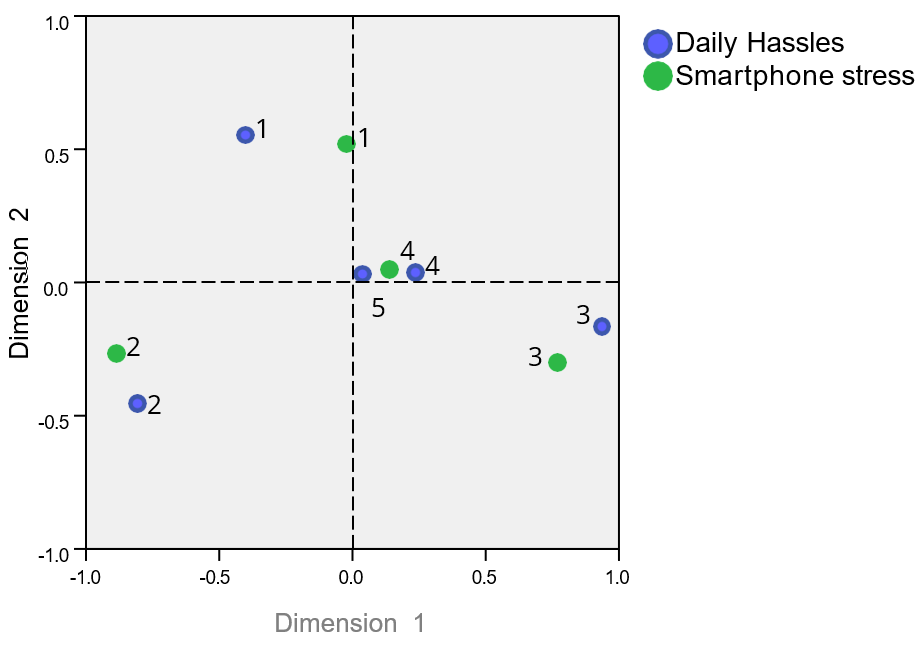
Figure 2. The Single Correspondence Analysis Between Smartphone Stress and Perceived Stress.

Figure 3. The Single Correspondence Analysis Between Smartphone Stress and Major Life Events.
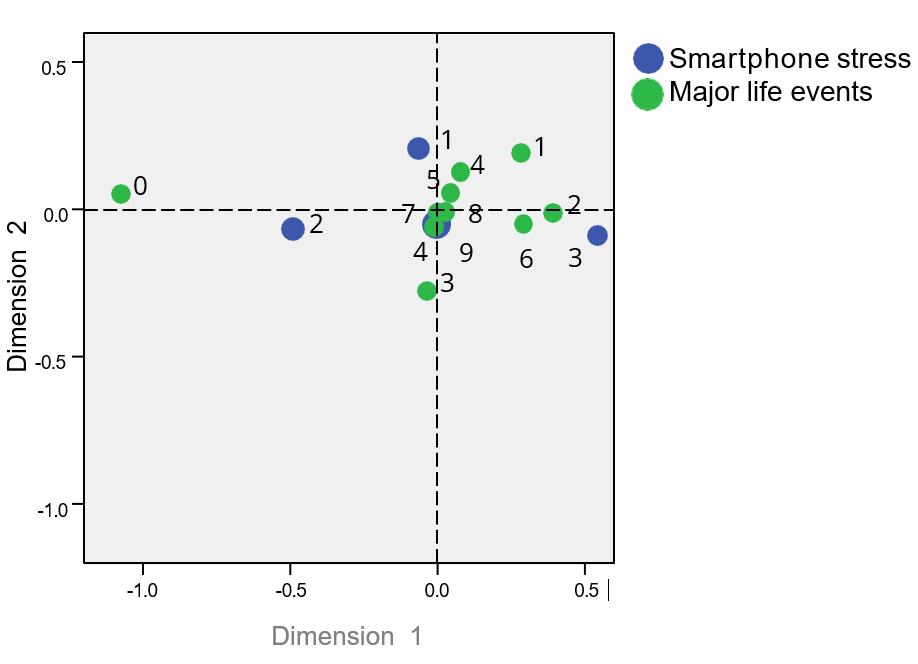
Note. The numerical integers in Figure 1–3 are the mean scores for each stress type, except for major life events, whose numerical integers indicate the number of experienced stressful life events. A higher numerical integer represents a higher experience of stress for each stress type. Dimension 1 (or 2) has an eigenvalue, representing its relative importance and how much of the inertia it explains. Dimensions can be interpreted based on how the variables’ categories separate on either side of the dimensions (Sourial et al., 2010).
The Co-Occurrence Between Online, Offline and Global Stress
Table 3 presents the eight LPA models between online and offline stress. As the number of identified profiles increases, the AIC, BIC, and aBIC decrease, and the p-values of LMRT and BLRT for the 5/7/8 profiles are not significant. Thus, it seems that the 6-profiles model and 4-profiles model were appropriate. However, the 4 profiles model had a higher entropy (entropy = .838) and it was more concise. Thus, the 4-profiles model is the best LPA model (see Figure 4). In Figure 4, class 1 (67.60%) was named as a no-stress profile because it had minimal smartphone stress, daily hassles, perceived stress, and major life events. Class 3 (15.75%) had slight smartphone stress, daily hassles, perceived stress, and moderate major life events, and it was named a slight-stress profile with moderate life events. Class 4 (3.44%) had moderate smartphone stress, general stress, and daily hassles, but had the highest life events, and it was named a moderate-stress profile with high life events. Finally, class 2 (13.21%) had the highest smartphone stress, perceived stress, and daily hassles, but had a low frequency of life events, thus class 2 was named the highest stress profile. The 4-profiles model showed that adolescents who experienced a certain level of offline stress experienced a similar level of smartphone stress, whether they experienced a life event or not. The H3 is supported.
Table 3. The Model Indicators of Latent Profile Analysis.
|
Class |
AIC |
BIC |
aBIC |
Entropy |
LMRT |
BLRT |
|
1 |
46,641.85 |
46,692.45 |
46,667.03 |
— |
— |
— |
|
2 |
44,963 |
45,045.23 |
45,003.92 |
.801 |
< .001 |
< .001 |
|
3 |
44,097.26 |
44,211.11 |
44,153.92 |
.834 |
< .001 |
< .001 |
|
4 |
43,697.17 |
43,842.65 |
43,769.56 |
.838 |
< .05 |
< .001 |
|
5 |
43,344.61 |
43,521.72 |
43,432.75 |
.773 |
> .05 |
< .001 |
|
6 |
43,002.92 |
43,211.66 |
43,106.80 |
.807 |
< .05 |
< .001 |
|
7 |
42,759.83 |
43,000.19 |
42,879.44 |
.813 |
> .05 |
< .001 |
|
8 |
42,515.47 |
42,787.46 |
42,650.82 |
.840 |
> .05 |
< .001 |
Figure 4. The Identified Latent Profiles for Online and Offline Stress.
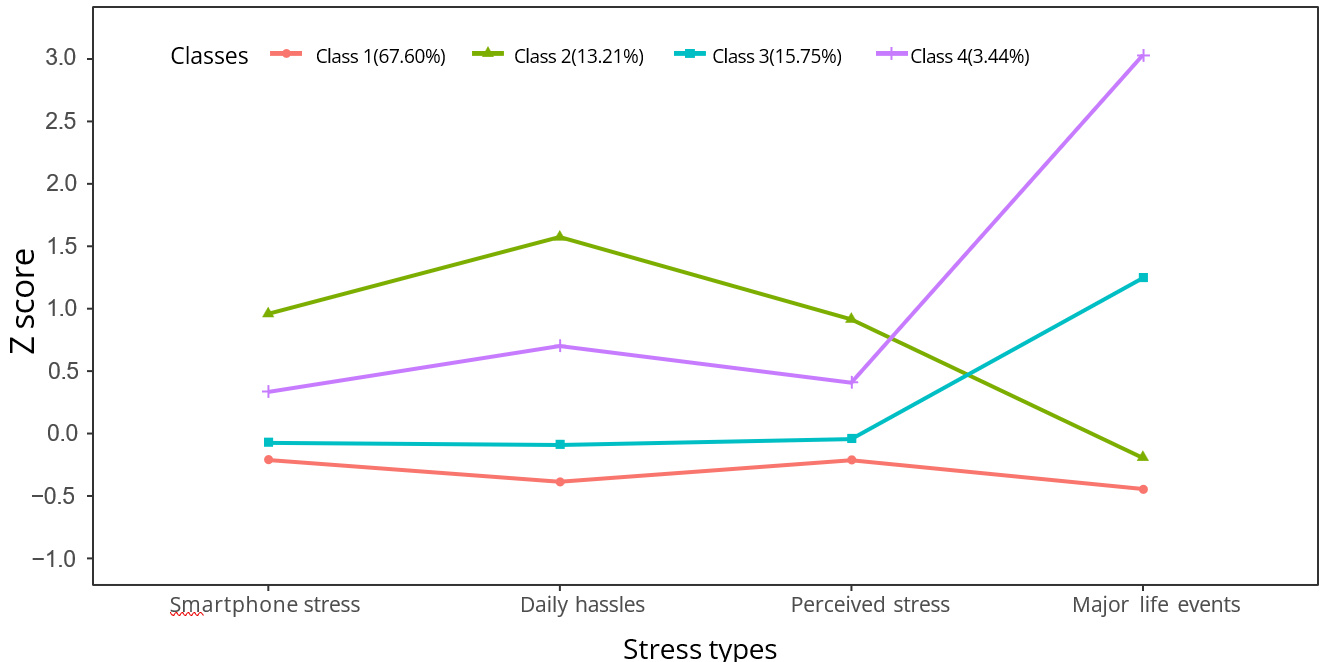
Note. Class 1 = no-stress profile, class 2 = highest stress profile, class 3 = slight-stress profile with moderate life events, and class 4 = moderate-stress profile with high life events. Each line represents different groups of adolescents with a certain level of stress across different types of stress.
The Accumulating Risks of Online, Offline and Global Stress
Figure 5 depicts the cumulative risk prediction of online and offline stress on various health outcomes. As risk factors (types of stress) increase, adolescents’ life satisfaction decreases, and the left outcomes (anxiety, depression, social maladjustment, and psychical complaints) increase. Stress risk factors showed a linear function with physical complaints (β = .368, p < .001, R2 = .135), anxiety (β = .496, p < .001; R2 =.291, p < .001), depression (β = .546, p < .001; R2 = .298, p < .001), and social maladjustment (β = .414, p < .001; R2 = .171, p < .001). While stress risk factors showed a quadratic curve function with life satisfaction (β = −.317, p < .001; quadratic = .080, p < .05; R2 = .088, p < .001). These results indicate that exposure to a greater variety of stress can be more detrimental to adolescents’ health.
Table 4 shows that the impact of each stress risk is lower when controlling for other risk factors, meaning that the cumulative risk of online and offline stress produces a greater impact than any single type of stress. Besides, the factor that contributed most to adolescents’ multiple well-being outcomes after controlling for other risk factors was daily hassles, |β| = .171~.374, p < .001, while perceived stress also showed an impressive and significant prediction on adolescents’ multiple well-being outcomes, |β| = .129~.330, p < .001. Moreover, after controlling for other stress, the impact of smartphone stress, |β| = .057~.238, p < .001, was comparable to the impact of daily hassles and perceived stress. Life events contributed the least to adolescents’ multiple well-being outcomes, |β| = .014~.079, p < .001. Overall, the H4 was supported.
Figure 5. The Cumulative Risk Prediction of Online and Different Types of Offline Stress.
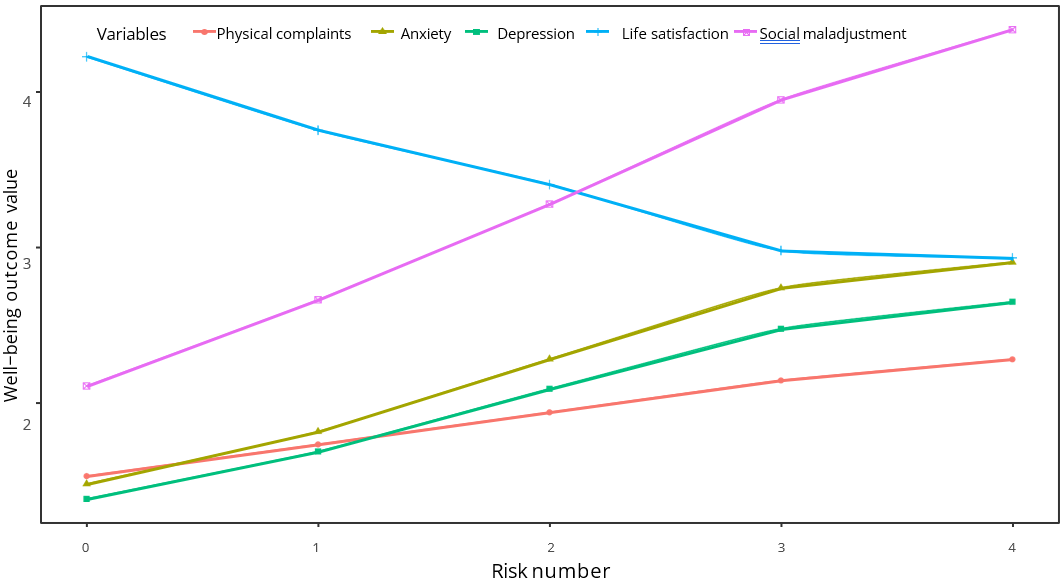
Table 4. The Prediction of Stress Risk Factors When Controlling or Not Controlling the Other Risks.
|
|
Not controlling for other risks |
Controlling for total other risks |
||||||||
|
Risk |
Physical complaints |
Anxiety |
Depression |
Life satisfaction |
Social adjustment |
Physical complaints |
Anxiety |
Depression |
Life satisfaction |
Social adjustment |
|
Daily hassles |
.309*** |
.443*** |
.477*** |
−.234*** |
.336*** |
.234*** |
.333*** |
.374*** |
−.171*** |
.250*** |
|
Life events |
.043a |
.084*** |
.082*** |
−.098*** |
.097*** |
.014b |
.036a |
.035c |
−.079*** |
.063*** |
|
Perceived stress |
.386*** |
.431*** |
.429*** |
−.253*** |
.301*** |
.129*** |
.330*** |
.327*** |
−.202*** |
.214*** |
|
Smartphone stress |
.268*** |
.349*** |
.332*** |
−.132*** |
.266*** |
.197*** |
.238*** |
.214*** |
−.057*** |
.181*** |
|
Total stress risk |
.368*** |
.593*** |
.546*** |
−.296*** |
.414*** |
|||||
|
Note. ***p < .001, ap = .006, bp = .345, cp = .007 |
||||||||||
Discussion
The Unique Aspect of Online Stress
This study showed that after controlling for various types of offline stress, online stress still had a significant negative effect on multiple well-being outcomes. This is consistent with our H1. It also confirms the theoretical aspect of the social media contextual framework from the perspective of online stress that it arises in cyberspace characterized by unique features (e.g., asynchronous; McFarland & Ployhart, 2015), rather than face-to-face conditions. However, smartphone stress shows less significant predictions on life satisfaction. This may be elucinated by a dual-factor model of mental health (Suldo & Shaffer, 2008), which proposes that evaluating health conditions should not solely focus on negative dimensions (e.g., psychopathologies such as depression), but that positive dimensions (e.g., subjective well-being) should also be considered. Consequently, people who experience certain levels of psychopathology may also maintain a positive outlook on life, which may protect their well-being. As previous research has indicated, measures of life satisfaction are sensitive to the entire spectrum of functioning encompassing indicators of both well-being and psychopathology (Proctor et al., 2009). Thus, life satisfaction itself would suggest two aspects of a dual-factor model that would attenuate or blend the effects of smartphone stress on life satisfaction. Furthermore, the different distribution scores between smartphone stress and life satisfaction may also explain such a weak effect (see Figures A1 and A2 in the Appendix).
The Differences Between Online and Offline Stress
The study revealed distinctions between smartphone stress and different types of offline stress. The results indicate that smartphone stress is most likely to be an online “daily hassles” and also has much overlap with perceived stress, while it is dramatically different from major life events. These results are consistent with previous research. For example, researchers have revealed a close relationship between online stress and perceived stress (Hall, Miller, & Christofferson, 2021; Hall, Steele, et al., 2021; Hudiburg, 1991; Tomczyk & Hoferichter, 2022). Besides, previous research has established that major life event is a completely different construct from daily hassles or perceived stress (Kanner et al., 1981; Martin et al., 1995), so it is reasonable that smartphone stress shows extreme distinctions with major life events. This study goes further than previous studies (e.g., Hall, Miller & Christofferson, 2021; Hudiburg, 1991) by not only comparing different types of offline stress but also by directly pointing out the overlap between online stress and different types of offline stress.
The Co-Occurrence Between Online and Offline Stress
The study discovered that people who experience a certain level of offline stress also experience a similar level of online stress. However, our previous findings suggest that online stress is unique and overlaps with offline stress (especially daily hassles). Therefore, this similar level of perception between online and offline stress may be explained as a potential transformation between offline stress and online stress. The transformation framework (Nesi et al., 2018a, 2018b) proposes that digital media transform adolescents’ peer experiences through five key aspects (amplifying experience and demand, altering the qualitative nature of the interaction, facilitating new opportunities for compensatory behaviors, and creating novel behaviors). The fact that adolescents (e.g., in China) are spending more and more time each day in online contexts (CNNIC, 2020, 2021) may create the potential for offline experiences to be transferred from offline space to cyberspace, and for online stress to do the same. According to the transformation framework, when people spend more time in cyberspace, offline stressors are also amplified and altered by the online context. The potential transformation may be highlighted by the unique feature of online space that distinguishes online stress (Nesi et al., 2018a), while also retaining the original aspects of offline stress. However, the LPA results can only show a potential transformation between offline and online stress, it fails to reveal how it transformed and whether this transformation is bidirectional (e.g., online stress is transformed into offline space). For example, when individuals engage in annoying interactions with family members in online cyberspace, this annoyance or stress spreads and is further experienced through offline face-to-face interactions (e.g., eating at the dinner table). Overall, more research, especially longitudinal or experimental, is needed in the future to explore the transformation process.
Another issue is that major life events do not show similar levels of stress to the online and other two offline stress. This does not vacillate the fact that online and offline stresses coexist, because major life event stress is featured by a very low frequency and high intensity, and it is a different construct with different health effects compared to other offline stresses (De Benedittis & Lorenzetti, 1992; Hahn & Smith, 1999; Kanner et al., 1981; Martin et al., 1995).
The Cumulative Effects of Online and Offline Stress
The results indicated that the acumulation of online and offline stress has linear or quadratic cumulative predictions on physical, psychological, and social health, indicating that cumulative exposure to different types of stress worsens adolescents’ well-being. And none of the stress types produced a greater effect than the cumulative effect. This is consistent with the cumulative damage hypothesis (Lupien et al., 2018), this study extends this hypothesis in terms of online and offline stress being cumulative. The results suggested that daily hassles had the highest predictions compared to the other three types of online and offline stress. Smartphone stress showed moderate predictions comparable to daily hassles and perceived stress, but life events showed minimal predictions. These results may support the previous view that daily hassles may be more pernicious than other types of stress (Kanner et al., 1981). Importantly, the effect of any single type of stress (online or offline) is smaller than the cumulative effect of the four types of stress, suggesting that in such a digital age, offline and online stress should be treated equally.
Theoretical and Practical Implications
First, this study confirms previous theories (e.g., the social media contextual framework) that present unique aspects of online space from a stress perspective and extends previous literature (Hall, Milller, & Christofferson, 2021; Hudiburg, 1991; Tarafdar et al., 2007) by scrutinizing the distinctions between online and offline stress, identifying that smartphone stress is similar to “daily hassles” (Huang et al., 2022) and that there is much overlap with offline stress. Second, this study not only confirms the cumulative damage hypothesis in the stress literature from an online-offline perspective but also highlights a potential research direction—the transformation between online and offline space. In addition, this study also has practical implications. Researchers focusing on online stress in work conditions have proposed several intervention strategies that were usually used for offline stress (e.g., positive psychology programs; Brivio et al., 2018). The overlap and co-occurrence of offline and online stress provide a theoretical basis for the effectiveness of traditional intervention paradigms towards online stress, but it also urges researchers to develop other interventions or coping strategies while considering the unique aspect of online stress (e.g., digital coping; Weinstein et al., 2016; Wolfers & Utz, 2022). At the same time, the transformation between online and offline stress and its cumulative effects can be helpful for policymakers. In the context of the intensive and complex interactions between our offline and online lives, individuals will experience more types of stress than in previous times when technology was not widespread, and this will have a worse effect on their health due to the cumulative effect. Thus, policymakers should consider how to reduce and help modern people cope with stress both online and offline from a public health perspective.
In addition to the implications above, there are some expectations for future research. Future researchers in this field can further explore what types of mechanisms or factors contribute to the overlap or co-occurrence of online stress and offline stress, and test whether there is a bidirectional relationship between online and offline stress. There is also a need to explore what types of individual traits or characteristics play a role in the perception of online and offline stress, and to compare their distinct and synergistic longitudinal effects on individuals’ social development.
Limitations
First, these results come from a sample of adolescents, who may not use digital media (e.g., smartphones) as frequently as adults. For example, 96.8% of Chinese juveniles have access to the Internet and 90.7% of them use smartphones, and 54% and 70% of juveniles spend more than half an hour online on weekdays and weekends, respectively (CNNIC, 2021). Thus, future studies could explore these issues among adults to test whether such phenomena would be more pronounced. Second, co-occurrence is cross-sectional and does not fully represent a direct transformation process between offline and online stress; future research could explore longitudinal co-occurrence at different time points and how this transformation occurs and whether there is a bidirectional transformation. Third, all data were collected based on self-reports, and subjective bias may affect the results. Fourth, using only smartphone stress to represent online stress would not be sufficient, especially for different cultures and age groups, which we hope future researchers will improve. Fifth, future research can go further by exploring how online and offline stress interact (e.g., exploring the relationship between different subdimensions of smartphone stress and other offline stress). Sixth, as the boundary between offline and online life becomes increasingly blurred, future research focusing on online and offline life should further clarify the conceptual issues of online and offline life (Navarro & Tudge, 2023). Finally, well-being outcomes are important indicators of children’s development, and while it is difficult to show the developmental trend in the present study due to its cross-sectional nature, longitudinal research is needed in the future.
Conclusion
Smartphone stress has unique features that distinguish it from offline stress, it has many similarities and differences with different types of offline stress, and it is more like an online “hassle” that is different from a life event. The co-occurrence between smartphone stress and offline stress suggests a complex interaction between online and offline life. Besides, online stress and different types of offline stress are cumulative and have increasingly negative predictions on multiple well-being outcomes. These findings highlight the theoretical literature and have practical implications.
Footnotes
1 Exchange rate: 1 $ = 7.3 CNY.
2 Chi-square test was conducted to determine whether there are differences between offline stress categories and online stress categories, and to guide the correspondence analysis later. A significant Chi-square value indicates the correlation between the two variables (Abdi & Béra, 2017; Khangar & Kamalja, 2017).
Conflict of Interest
The authors have no conflicts of interest to declare.
Acknowledgement
We thank the finding from the Major Program of National Social Science Fund of China [grant number 20&ZD153]; we also thank the constructive comments from the anonymous reviewers.
Appendix
Figure A1. The Score Distribution of Online and Offline Stress.
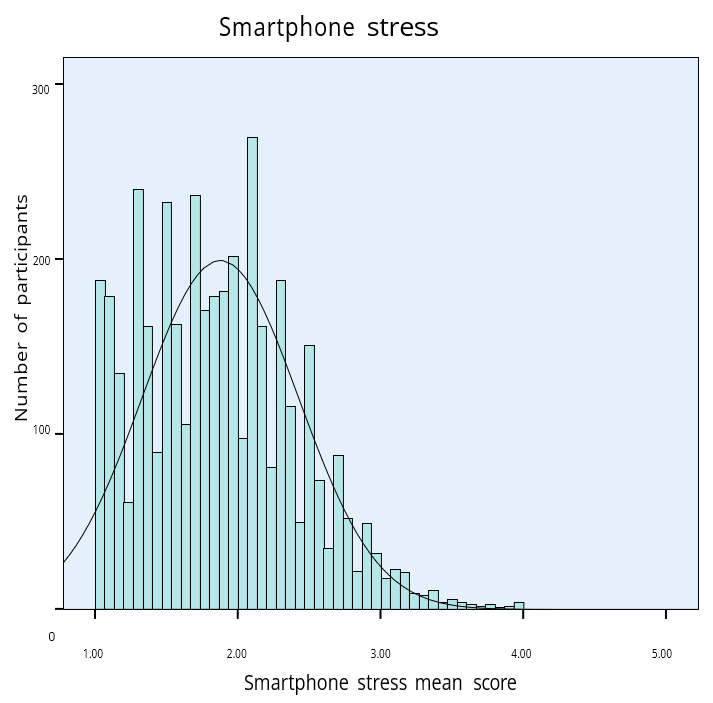
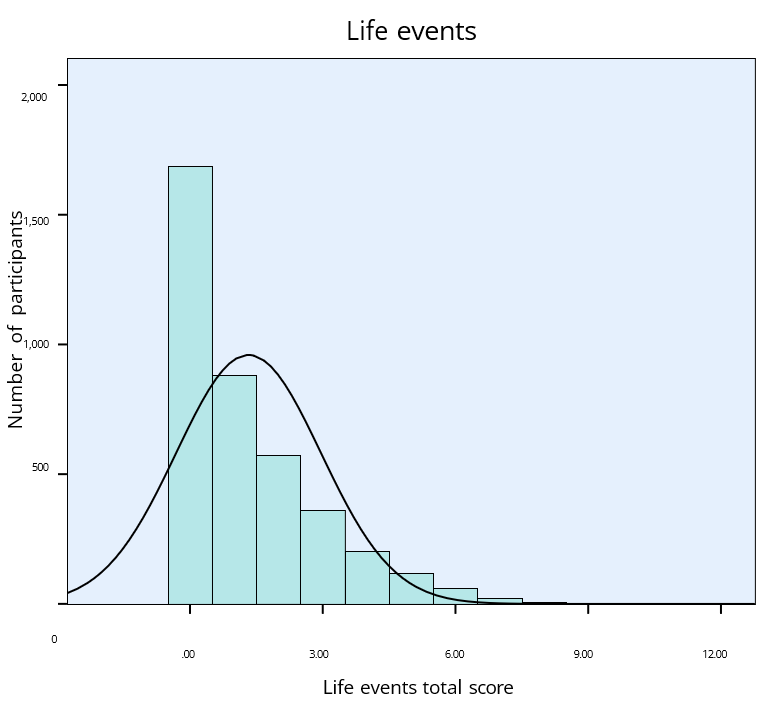
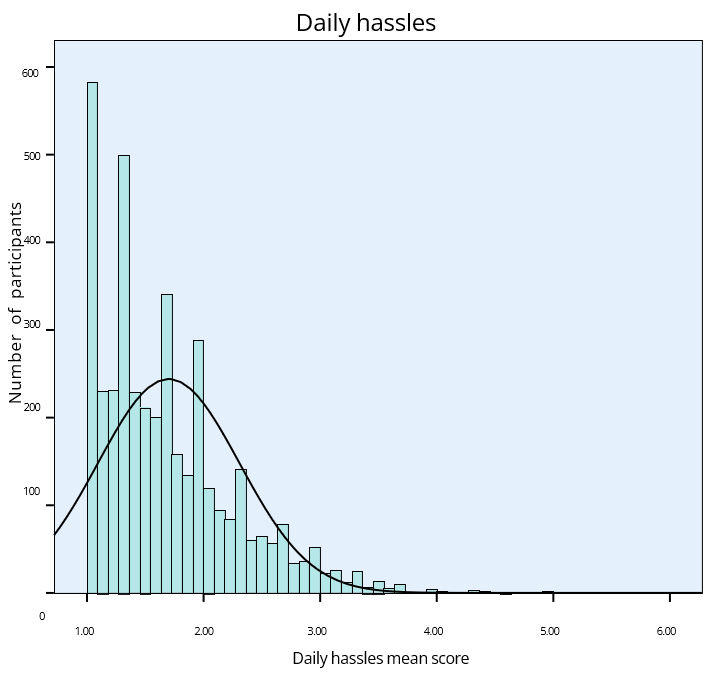
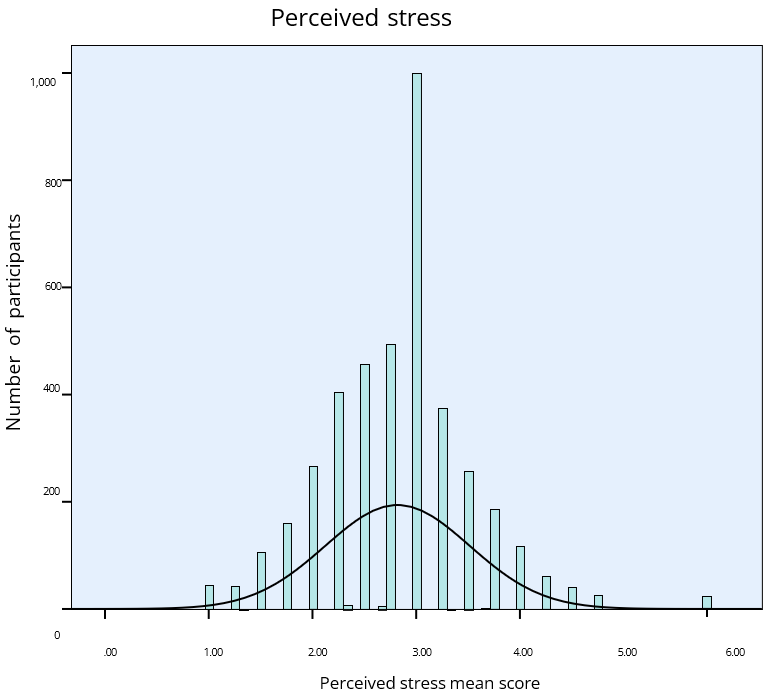
Figure A2. The Score Distribution of Multiple Well-Being Outcomes.
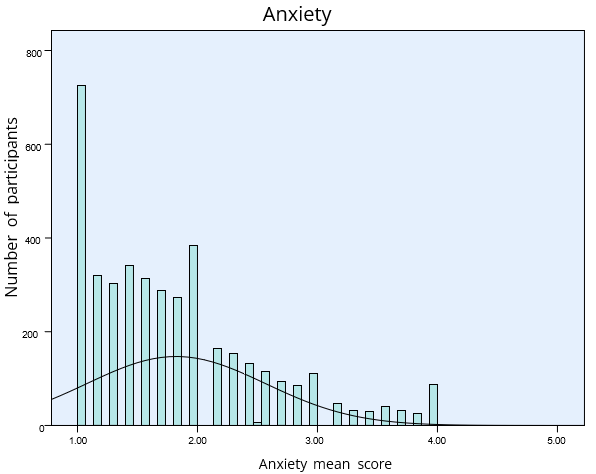
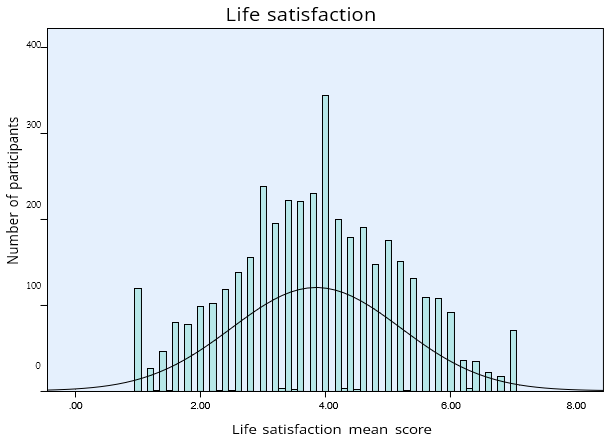
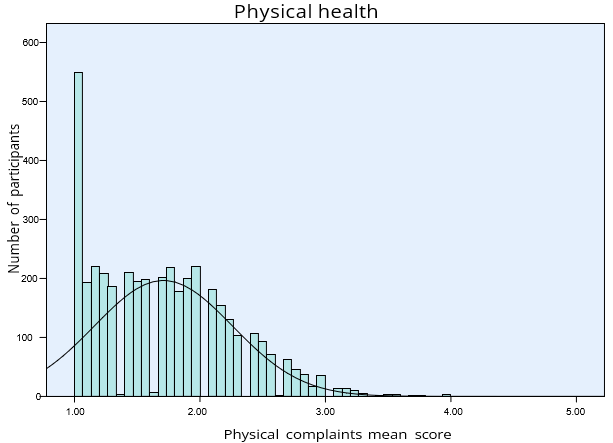
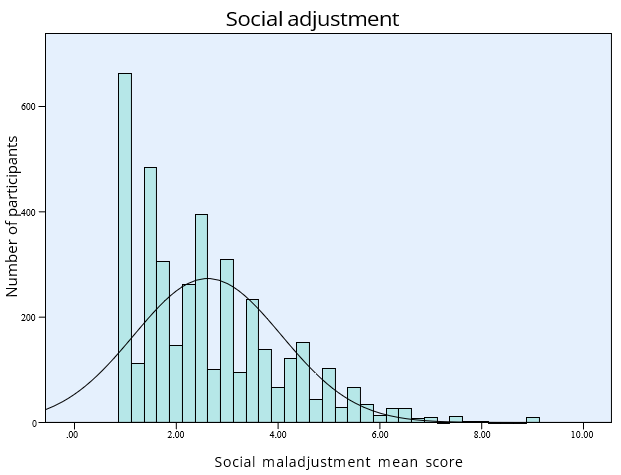

This work is licensed under a Creative Commons Attribution-ShareAlike 4.0 International License.
Copyright © 2024 Shunsen Huang, Xiaoxiong Lai, Lara Wolfers, Yajun Li, Xinran Dai, Xinmei Zhao, Hongyun Wu, Sirong Song, Huanlei Wang, Ying He, Yun Wang



